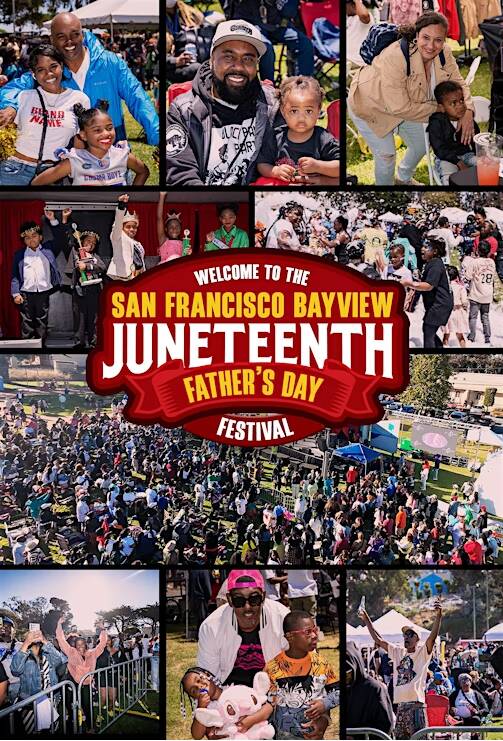
by John William Templeton
Special to the Bay View and Post News Group
When 180,000 formerly enslaved Africans in Texas were freed by the U.S. Army, they registered to vote in proportions over 90% and were the majority of voters for the Texas constitutional convention in 1866. The Jubilee Day on June 19 was an important organizing tool.
Wesley Johnson brought the observance to San Francisco in that same spirit. As owner of the Hotel Texas and Club Flamingo in the 1800 block of Fillmore, he had been on a mission to encourage Blacks to move from Texas to San Francisco since his time as president of the Utopia Negro Students Club at San Francisco State University. In 1935, he had invited the Great Debaters from Wiley College to compete with San Francisco State and UC-Berkeley, defeating both.
With shipbuilding jobs opening up, Johnson knew Juneteenth would get Texans’ attention. So, he rode a white horse with his signature white cowboy hat down Fillmore Street to start a tradition that is more than 80 years old.
Because he used this historical event, African-Americans who came to the Bay Area built record numbers of ships and became members of labor unions, leading to unprecedented political influence.
Thirty years later, one of the Texans he attracted, Mary Helen Rogers, co-founder of the Western Addition Project Area Committee, took over the helm for another 30 years. It was her way of keeping everyone on the same page.
Rogers, who had a ninth grade education and 12 children, nevertheless bested Ronald Reagan and Richard Nixon in federal court by requiring restitution for those harmed by federal policy. It led to the Uniform Relocation and Assistance Act in 1971.
Standing with her was LeRoy King, northern California president of the International Longshore and Warehouse Union, which had fostered the integration of Black and white workers as early as the general strike of 1934.
The church-labor movement they supported created a string of electoral successes beginning with Terry Francois for San Francisco supervisor and Willie L. Brown for state assemblymember, eventually to become speaker and mayor.
It was all a function of organized labor. In my Black History Month kickoff speech at City Hall in February, I suggested that African-American history should be seen as labor organizing.
Without access to capital, African-Americans have turned to cooperative economics to meet their needs. Rogers was one of the founders of Westside Community Health, which has operated for 50 years with cultural proficiency in mental health. That’s a result of Juneteenth.
While producing the documentary “BlackWomanComing: They Scared of Mary Helen Rogers,” I reflected on how political and economic leaders knelt at her feet because once a year they had the image of a united community getting direction from her.
A keen judge of how her community was perceived, Rogers retained me to figure out what actually happened on June 19, 1865. The myth didn’t make sense. Texas had been part of Mexico just 20 years earlier, which banned slavery.
I went to a bulletin board for African-American historians and posed that question. Within 20 minutes, I heard from the author of the history of Blacks in Texas and the author of the history of Texas who both remarked that they had been waiting for decades for someone to ask them that question, denouncing the myth, which was already law in Texas, as preposterous.
So I prepared a statement for San Francisco Juneteenth program that accurately points out that Galveston was in Union hands on Jan. 1, 1863, which is plainly visible on Galveston’s web site, and that five regiments of U.S. Troops of African Descent occupied the South Texas coast from November 1863 past the end of the war.
The notion that Black Texans didn’t know about the Emancipation Proclamation is not possible. We have to understand the tenacity of slaveholders during the Civil War. The U.S. Army had to capture, often burn to the ground plantations in order to release African-Americans. By 1865, only 1 million of the 3.6 million enslaved had been freed. Texas was spared combat after the action shifted to Virginia. It took an additional year after June 19 for the U.S. Army to physically visit every plantation in Texas and free those enslaved, then protect them from violent attacks. They used that first Jubilee Day to register to vote in a ratio of over 90%.
James Brown said, “In order to get down, you’ve got to get in deep.” It is a travesty to Wesley Johnson and Mary Helen Rogers to see the national holiday as a reason to party. Social media has amplified a dangerous message of Black ignorance instead of what is our greatest victory.
I’m joining former Supervisor Sophie Maxwell and Dr. Carolyn Ransom Scott, chair of the board of the former Redevelopment Agency that Rogers conquered, on a panel June 6 for the 14th Rafiki Coalition Black Health Summit to describe how we move Rogers’ focus on health forward.
On June 19, ILWU Local 10 President Demetrious Williams and I will lead an ILWU 10 Juneteenth to underscore the labor organizing tradition of Juneteenth at the Labor Temple in Fisherman’s Wharf.
I’ll also make an announcement about TheSargent: Sargent Claude Johnson National Museum of African American Art at Pan African Place.
Johnson and Rogers always brought folks together with a purpose, with clear objectives and deliverables that have endured for generations. Let’s be true to their standard.
John William Templeton is the author of “The Black Encyclopedia” and “ReUNION: State of Black Business,” 22nd edition, the source for the history of Black labor during Black History Month 2025, along with a trilogy on the 13th, 14th and 15th Amendments and the four-volume history of African-Americans in California. He is founder of the 21st Journal of Black Innovation National Black Business Month which replicates the 1920 Garvey conference for 31 days in August in San Francisco. He is also publisher of the “Journal of Black Innovation” and editor of Blackmoney.com. Learn more in this Examiner story, “From Bernal to Pacific Heights, John Templeton tracks Black lives.”




